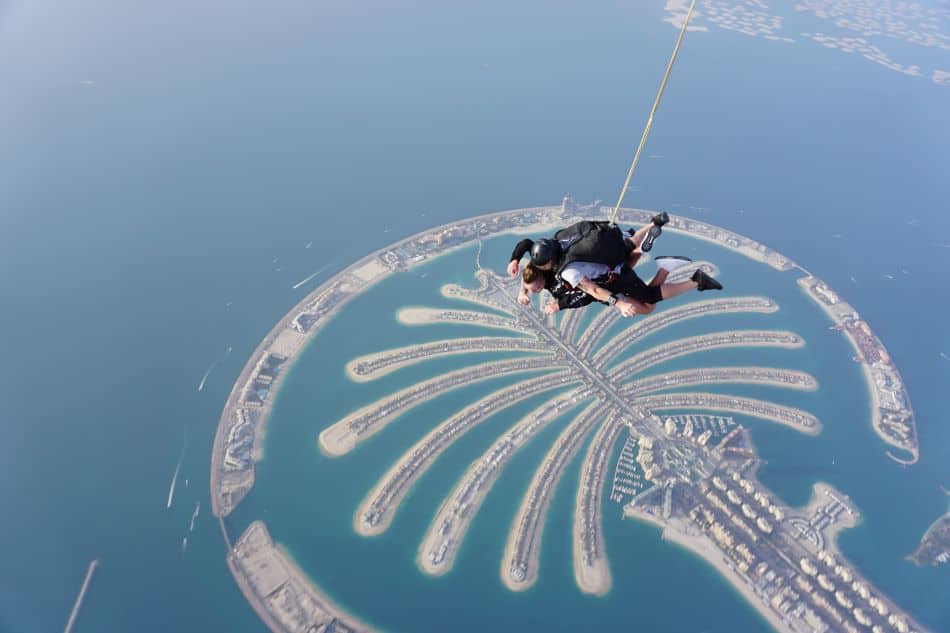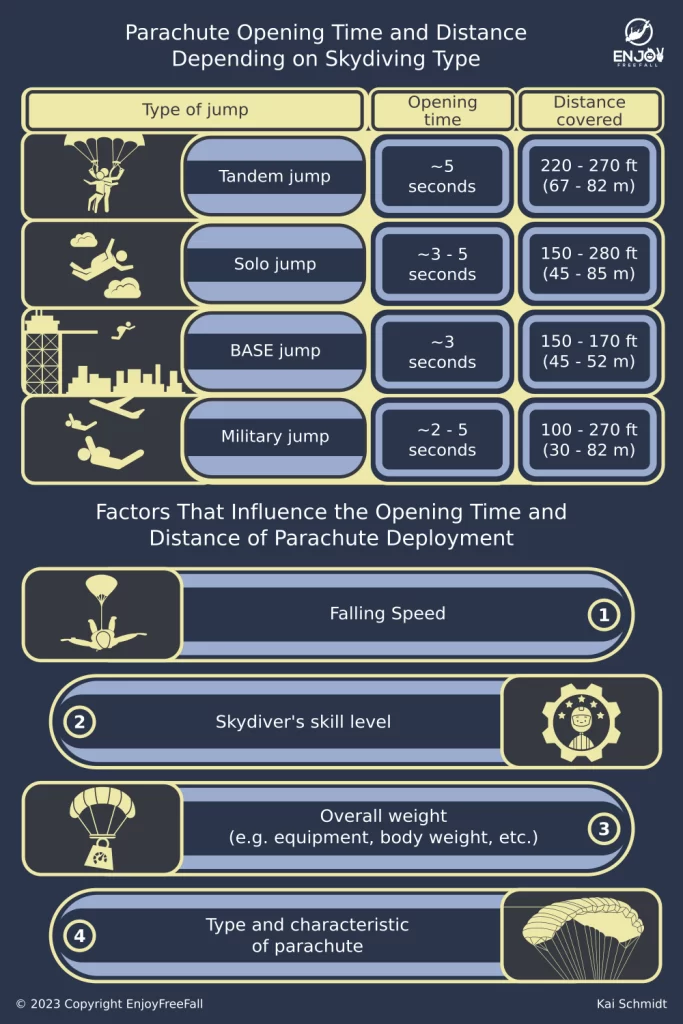
Skydiving is one of the unforgettable experiences in which people are carried away and lose their feeling of time and speed. After a jump, many novice skydivers wonder about the different technical details of their jump. One of the most common questions is how fast does a parachute open?
On average, it takes only about three to five seconds for a parachute to inflate after its opening mechanism is activated. The distance covered during this time is around 135-160 feet (40-50 meters) depending on the falling speed and parachute type.
The speeds and distance at which a parachute opens can vary widely depending on a range of factors, including the type of parachute, the rate at which the person falls, and the skydivers’ skill. In this blog post, I will explore these factors and clear up common misconceptions about parachute deployment, giving you a better understanding of this thrilling activity.
The Parachute Opening Time and Distance Depending on Skydiving Type
The table below shows the average opening times and distances covered for different types of skydivers under typical conditions.
| Type of Jump | Opening Time of Parachute | Distance Covered During Parachute Opening |
| Tandem Jump | ~5 seconds | 220-270 ft (67-82 m) |
| Skydive Solo Jump | ~3-5 seconds | 150-280 ft (45-85 m) |
| Base Jump | ~3 seconds | 150-170 ft (45-52 m) |
| Military Jump | ~2-5 seconds | 100-270 ft (30-82 m) |
As you can see the type of jumps makes a huge difference because it determines the different factors that influence the opening time such as speed, skills of skydivers, weight, and type of parachute.
It might be most surprising that the military has the biggest range of parachute deployment time and distances. This is caused by the fact that military jumpers have different missions and therefore use different parachutes with their own opening characteristics, exit altitudes, and deployment heights.
In the following abstract, I will give a quick overview of how the different factors influence the opening time and covered distances during parachute deployment.
Falling Speed Influences the Opening Time and Distance of Parachute Deployment
Here it is time to clear the first common misconception. Many people believe that a skydiver falling at a higher speed experiences a longer opening time for the parachute. In fact, the opposite is true. The parachute deploys faster because more air is pressured into the parachute. What is typically meant by most people is that skydivers falling at higher speeds experience a longer deceleration or “braking” time when deploying their parachute.
The distance covered during the opening process is also affected by the falling speed. A skydiver falling at a higher speed will cover more distance during the opening process compared to a skydiver falling at a lower speed, due to the greater amount of time it takes for the parachute to fully open.
The distance covered during the opening process can be significant and should be taken into account when planning a landing, especially in areas with limited landing options. For this reason, experienced skydivers often aim to stabilize their falling speed before deploying their parachutes to ensure a smoother and more predictable opening.
The body position of a skydiver is one of the most important factors that can affect their falling speed during freefall. The speed of a skydiver is at its lowest when in a belly-to-earth position, while the head-down position is the fastest.
For safety reasons, skydivers typically aim to deploy their parachute while in a belly-to-earth position, which allows for a more stable and controlled descent.
Beating the odds: Parachute failures during skydiving are rare, but they are normally catastrophic. However, there are some people who survived this terrifying situation. Learn more about their incredible stories and strategies to avoid certain death in this blog post.
The Skydivers Skill Determine the Opening Time and Distance of Parachute Deployment
The skill of a skydiver in deploying their parachute can significantly impact the opening time and distance covered during deployment. Experienced skydivers can use their knowledge of parachute design and their body position to optimize the opening process, ensuring a smoother and more predictable descent.
A skydiver with good technique can also react to unforeseen circumstances and troubles much faster. If lines are entangled, they typically resolve the problems within seconds.
Obviously, problems during parachute deployment increase the opening time and distance covered during parachute deployment.
Weight Impacts the Opening Time and Distance of Parachute Deployment
A heavier skydiver will generally fall at a faster speed than a lighter skydiver, which results in a faster opening time and greater distance covered during deployment because more air is pressured into the parachute. The impact of weight is sometimes outbalanced by that of the parachute design.
For example, parachutes for tandem skydiving are generally bigger than those for solo skydivers. As a result, the tandem parachute will inflate slower than the solo parachute. It generally holds true that a skydiver’s weight should be taken into account when selecting a parachute, deployment altitude, and technique.
Weight might also influence the targeted descent rates after a parachute is opened. In tandem skydiving, it is generally aimed for a smooth and easy landing as possible. As a result, the speed at which skydivers descend with an opened parachute is comparably slow.

The Type and Characteristics of Parachutes Are Essential in Determining the Opening Time and Distance of Parachutes
The design of a parachute can have a significant impact on the opening time and distance covered during deployment. The size, shape, and material of the canopy can affect the inflation rate and drag of the parachute. Parachutes with larger canopies tend to open more slowly but provide greater lift and stability, while smaller canopies offer a faster opening time and greater maneuverability but are less stable.
The type of suspension lines and the number of attachment points can also influence the opening time and overall performance of the parachute.
Typical solo skydives, tandem jumps, BASE jumping, and military jumps each present unique challenges and considerations when it comes to parachute design and deployment. Tandem skydiving requires parachutes that are specifically designed to support the weight of two people and provide a controlled, comfortable descent.
Base jumping often involves jumps from fixed objects at low altitudes, which require parachutes that open quickly and reliably to allow for a safe landing. Military jumps may involve high-altitude, high-speed deployment, and require specialized equipment and training to ensure safe and successful jumps.
Are you ready to experience the thrill of skydiving, but feeling a little nervous about the landing? Fear not! In this comprehensive guide to tandem skydiving, I cover everything you need to know about the landing process. Get ready to feel the rush of the freefall and land safely and confidently with Skydiving 101.
How Fast Do You Fall with a Parachute Open?
As a general rule, the descent rate with an opened parachute ranges from 12-17 mph (19-27 km/h) depending on the type of skydive and parachute. In tandem skydiving, the average descent rate is 15 mph (24 km/h).
As with the inflation time, the rate of descent during the canopy ride depends on the type of jump:
Tandem skydiving typically has a slower speed of descent after the break at 12-14 mph (19-22 km/h) to give tandem students a longer and more memorable experience. It also ensures a safer landing for the students and instructor.
Solo skydiving and base jumping have similar speeds of descent after the break at 15-17 mph (24-27 km/h).
Military jumps tend to have a slower speed of descent after the break at 13 mph (21 km/h).
This is often due to the fact that military jumpers carry significant equipment with them. The equipment results in greater weights and a higher potential impact for soldiers. Therefore military parachutes are designed to break more before landing ensuring that soldiers are not injured. There are obviously cases where soldiers need to land with less equipment or equipment is sent down separately. In those cases, the descent rate will be higher.
Speaking of the military, are you interested in knowing how special forces use skydiving in their operations wearing wingsuits, whether it is similar to what it looks like in Hollywood movies? In my article here, I demystify the common myths about military skydiving operations. The answer will surprise you!
Several maneuvers can also influence the descent rate with an open parachute. One example is flaring. It is a technique used by experienced skydivers to slow down their descent just before landing. By pulling down on the rear risers of the parachute, the skydiver can increase the angle of attack of the canopy and generate more lift, which reduces their vertical speed.
Toggling, on the contrary, is a technique used to control the descent rate and forward speed of the parachute during the canopy flight phase. By pulling on the steering toggles of the parachute, the skydiver can increase or decrease the amount of lift generated by the canopy, which can affect their descent rate and forward speed.
How Fast Do You Hit the Ground with a Parachute?
On average, skydivers hit the ground with a speed of 10 mph (16 km/h), which is roughly equivalent to the force experienced when jumping off a tall object ranging from 8 to 13 feet. A speed up to 17 mph (27 km/h) is usually considered a safe landing.
Skydivers typically use maneuvers such as flaring to slow down their descent rate and reduce their vertical speed to ensure that they have lower speeds than 17 mph (27 km/h). For skydivers, it gets extremely dangerous when landing at speeds above 35 mph. It can result in severe injuries, highlighting the importance of proper training, equipment, and technique when engaging in any kind of skydiving or parachuting activity.
Enjoy your free fall!




